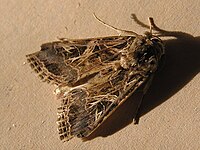
Photo from wikipedia
Simple Summary Spodoptera littoralis (Boisd) is a highly polyphagous and destructive pest, which attacks a wide range of economically important crops throughout the world. The extensive use of conventional insecticides… Click to show full abstract
Simple Summary Spodoptera littoralis (Boisd) is a highly polyphagous and destructive pest, which attacks a wide range of economically important crops throughout the world. The extensive use of conventional insecticides for management of S. littoralis has resulted in development of resistance to major classes of pesticides and can have a negative impact on the environment. It is necessary to investigate alternative pest management approaches that are more cost-effective and sustainable than conventional insecticides. The aim of this study was to identify potential sources of variation in resistance/susceptibility of legume cultivars to S. littoralis, and to describe potential interactions between cultivar traits and digestive function of this pest. We conducted life table analyses and assessed both proteolytic and amylolytic activities of S. littoralis on 11 common legume cultivars. The findings indicated that S. littoralis reared on the common bean, Arabi, displayed the highest intrinsic rate of increase, while the lowest was recorded on the cowpea, Mashhad. Developmental time of S. littoralis larvae was negatively correlated with protein content, while amylolytic activity was positively correlated with starch content of legumes. Our results revealed that the Mashhad cultivar exhibited tolerance traits against S. littoralis, which may prove useful for integrated programs that aim to reduce chemical inputs. Abstract Spodoptera littoralis (Boisd) is a highly destructive pest that attacks a large number of economically important crops. We examined life table parameters as well as activity of major digestive enzymes of S. littoralis larvae in response to protein and starch contents across 11 legume cultivars to identify potential resistance traits. The results showed that S. littoralis reared on the common bean, Arabi, displayed the highest intrinsic rate of increase (r), while the lowest was recorded on the cowpea, Mashhad. Also, the highest net reproductive rate (R0) was obtained in those insects reared on the Arabi cultivar. Larvae displayed the highest and lowest proteolytic activities when fed on Mashhad and Arabi cultivars, respectively. The highest amylolytic activity was quantified in larvae that fed on the Arabi and 1057 cultivars, while the lowest occurred in larvae feeding on Yaghout and Mashhad cultivars. Developmental time of S. littoralis larvae was negatively correlated with protein content, while amylolytic activity was positively correlated with starch content of legumes. Our findings indicate that Arabi was a susceptible cultivar, while Mashhad exhibited tolerance traits against S. littoralis. These results should facilitate selection of legume cultivars for production or breeding efforts that involve S. littoralis management.
Journal Title: Insects
Year Published: 2022
Link to full text (if available)
Share on Social Media: Sign Up to like & get
recommendations!